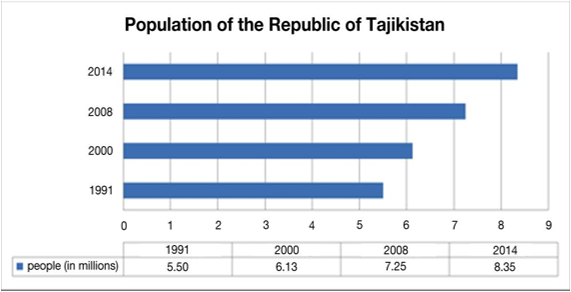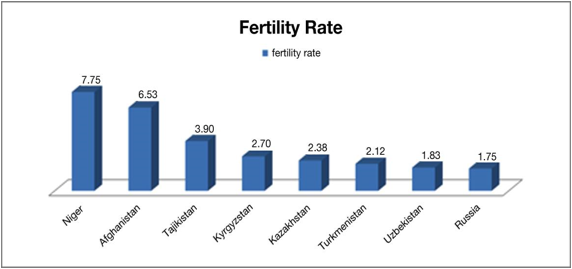“It must be admitted that today, outside of the bureaucrats’ bravura proclamations of hundreds of thousands of newly created jobs in Tajikistan and the sparkling official unemployment statistics, there have been no real successes in controlling the demographic situation in the country,” – Mikhail Petrushkov, a specialist from Dushanbe, analyses the demographic situation in Tajikistan in this cabar.asia exclusive.
 Tajikistan’s demographic problem has become even more relevant in the face of the growing financial and economic crisis in the post-Soviet space, labor surpluses, increases in unemployment, and limited resources in the country. It must be admitted that the nation’s leadership are only in the earliest stages of a long, painstaking effort to form a comprehensive demographic policy.
Tajikistan’s demographic problem has become even more relevant in the face of the growing financial and economic crisis in the post-Soviet space, labor surpluses, increases in unemployment, and limited resources in the country. It must be admitted that the nation’s leadership are only in the earliest stages of a long, painstaking effort to form a comprehensive demographic policy.
Currently, of all Tajikistan’s accomplishments we can only truly consider the passing in 2002 of Tajik state demographic policy’s founding document: “On the Concept of State Demographic Policy of the Republic of Tajikistan, 2003-2015″ (Approved by the Government of Tajikistan on 6 May 2002, № 201).
Among the notable accomplishments in realizing the Concept’s objectives is the legal ban on marriage between close relatives and mandatory prenuptial medical exams for newlyweds. These measures are aimed at decreasing the number of underdeveloped children and children with birth defects born in the country. According to the Ministry of Health and Social Welfare there are 26,000 children with disabilities officially registered in Tajikistan, and this overwhelming number is due to one centuries old problem: incest.
Additionally, the mandatory medical examinations for newly-weds are aimed at identifying preexisting and potential threats to family health and the health of future generations of Tajik citizens.
In order to achieve the results as required by the Concept, the Tajik government adopted a number of laws including:
- “The Healthy Lifestyle Program for the Republic of Tajikistan, 2003-2010” dated 3 March 2003, №84
- “On Youth and State Youth Policy” dated 15 July 2004, № 52
- “National Healthy Lifestyle Program for the Republic of Tajikistan, 2011-2020,” dated 30 October 2010, № 560
- “On the Prospects of Preventing and Controlling Non-communicable Diseases and Injuries in the Republic of Tajikistan, 2013-2023,” dated 3 December 2012, № 676
These steps have led to not only a decrease in childhood, maternal and general mortality in Tajikistan but also an increase in demographic indicators such as life expectancy at birth.
However, efforts have been limited to these fundamental successes. With the exception of sporadic programs and a few population control measures, most programs are either projects run by international donor organizations in Tajikistan or partnerships between the Tajik government and international structures. To this day, a strategy of demographic policy with a list of concrete actions and sources of funding has not been developed in the country.
Demographic Picture of Tajikistan
Before beginning our brief examination of the demographic picture of the Republic of Tajikistan, we must note that we can only provide a rough estimate. Much of the national statistical data, which would paint a negative picture of current demographic trends, is currently unavailable. It is also worth noting that statistical data from 1991 to 1999 is not publically available.
An analysis of the available statistical data indicates a sharp increase in the Tajik population.
Table 1
As such, the population of the Republic of Tajikistan has increased by nearly 3 million between 1991 and 2014. And this is despite massive depopulation (primarily of the Russian-speaking population) and heavy civilian casualties as a result of the tragic events of the 1990s.
Particularly significant is the increase in the population during the inter-crisis period from 2008 to 2014. During this 6-year period the Tajik population increased by more than 15% adding 1.1 million more people.
As such, there is one fact that seems at first glance to be a paradox, particularly for European countries: regardless of difficult socio-economic conditions, limited natural resources, growing unemployment, falling incomes, and an increase in involuntary labor migration, the population of the Republic of Tajikistan is growing dramatically. These demographic processes are a distinctive feature of many of the world’s poorest, least developed countries, in which having multiple children is practically the only way for a family to survive as a social unit.
Fertility rates (number of births per woman) in Tajikistan are inching closer to 3.9 births per woman.
Of course, Tajikistan is far behind the fertility rate leaders in such as Niger (7.75) and Afghanistan (6.53), however Tajikistan is the leader in this area by a large margin in the post-Soviet space according to statistical data for 2014 from the Tajik Presidential Statistics Agency.
Table 2
In today’s Tajikistan, with its low standard of living, large families are not conducive to properly educating the younger generation.
Chronic malnutrition among children, an increase in the number of children with physical or developmental disabilities, and an increase in truancy among adolescents have become true societal “scourges”. In rural areas, for example, due to an increase in radical religious sentiments among the lesser-educated population, teenage girls have begun dropping out of school due to pressure from their parents. Teenage boys drop out or attend school in name only while working odd jobs or in the fields with their parents.
Taken together this will lead to a lower-quality generation that is spiritually underdeveloped, poorly educated, unqualified, and unsuitable for employment in modern high-tech industries as well as an increase in the number of juvenile offenders.
Additionally, the dramatic population growth impacts the ecology of Tajikistan through de-urbanization, spontaneous return migration (city to village) to previous places of residence in mountainous regions, intensive housing construction in areas zoned for agriculture, unmanaged “pressure” on the flora and fauna, complete deforestation during the winter for heating and cooking, the contamination of rivers and lakes, etc. This has upset the delicate natural balance nationwide and has led in some cases to environmental disasters.
The high level in annual population growth is occurring simultaneously with slow economic growth. These aforementioned factors combined with limited natural resources have become serious obstacles to solving the problem of sustainable development in the Republic of Tajikistan.
Additionally, statistical data showcases an increase of one other very important indicator: the number of able-bodied and economically active individuals.
In 1991, according to the data of the Tajik Presidential Statistics Agency, 3.84 million people out of a total population of 5.5 million were considered able-bodied. In 2014, there were more than 5 million out of a total population of 8.35 million. As such, according to rough estimates the number of able-bodied individuals in Tajikistan has grown by 1.2 million people since independence.
Unintentional Assistance
Currently, a number of factors help mitigate Tajikistan’s difficulties in providing employment opportunities.
Of course, the first and most important mitigating factor is labor migration to the Russian Federation and the Republic of Kazakhstan. According to various and admittedly contradictory statistics, between 400,000 and 2.5 million Tajik citizens are engaged in labor migration. Some of these Tajiks have already gained citizenship of another country.
Another important mitigating factor is self-employment. Currently, the number of self-employed citizens of either gender in Tajikistan has grown to 1 million people according to official statistics. Independent experts claim that this number is actually closer to 50% of the total able-bodied Tajik population.
De-urbanization is yet another important mitigating factor, albeit one that is rather negative for modernization. Data from the Tajik Presidential Statistics Agency indicates that the number of citizens living in rural areas has grown since independence from 69% in 1991 to 73.5% in 2014.
Most experts believe that this process is connected to involuntary rural migration due to unfavorable economic conditions characterized by an increase in the unemployment rate and the cost of living in cities.
Regardless of the aforementioned factors, the labor surplus in Tajikistan, however, is growing rapidly.
To mitigate the situation, the Tajik government has taken a number of steps, the most effective of which according to Tajik officials is the adoption of the “Concept for the creation and preservation of jobs in the Republic of Tajikistan for 2008-2015” (approved on 5 March 2008, № 74).
According to independent experts this concept, like the majority of documents related to demographic policies in Tajikistan, is mainly of a descriptive nature. The tasks are unfunded, not supported by concrete step-by-step actions or effective measures, and remain only declared efforts on the part of the Government.
In many ways this Concept echoes earlier documents such as the Concept of State Demographic Policy of the Republic of Tajikistan for 2003-2015 and the Program Passport for the Realization of the 2003 – 2015 State Demographic Policy Concept (adopted by decree № 501 on 31 December 2002).
Current Demographic Realities
It must be admitted that today, outside of the bureaucrats bravura proclamations of hundreds of thousands of newly created jobs in Tajikistan and the sparkling official unemployment statistics, there have been no real successes in controlling the demographic situation in the country.
In analyzing the age patterns of the population through comparisons of the different age cohorts and their attitudes towards work, we see a picture that is simultaneously pleasing and disappointing. In all categories an absolute and relative majority of the population is able-bodied. The working-aged population is several times more numerous than those individuals at or near retirement age.
On one hand, this is a very favorable of demographic balance for the nation’s economy, because Tajikistan has incredibly powerful labor potential.
However, this potential is a double-edged sword. It is a very real engine for industry and the economy, however it could creates an explosive situation in society caused by a lack of intensive job creation and a high level of unemployment. The situation is complicated by the fact that the size of the pre-working age population is incredibly large, which is in and of itself a ‘time bomb’.
It must be admitted that the demographic situation is rapidly deteriorating and demands the development and implementation of a number of emergency measures. At present there have been several, often diametrically opposed, approaches to the demographic problems.
There are more than a few experts in the country that are calling for actions aimed at drastically reducing the birth rate. They reinforce their arguments with successful examples drawn from international best practices such as the Chinese approach. In China each family by law was allowed to give birth to one child, which allowed national authorities to stabilize the uncontrollably, snowballing population growth.
Tajik authorities, however, in developing the principles for state demographic policy enshrined a fundamental principle: “…the Concept of the Tajik State Demographic Policy is based on the fact that the use of violence and arbitrary decisions cannot be regarded methods to manage demographic processes.” This principle is based on human rights and the rights of the individual and is supported by the overwhelming majority of representatives of Tajik society.
Additionally, it must be noted that, in spite of the serious family planning measures carried out in Tajikistan, the high fertility rate not only persists but also continues to climb.
What to do? What steps to take?
To address the “demographic tension”, the authors of the 2003-2015 Concept included “…an increase in migration, in particular labor migration…” among the primary objectives of the state.
In sharing the view of these experts, we would like to emphasize that, in our view, a multifaceted approach that promotes synergy is required that includes the following steps:
- Create an expert community that includes representatives from government agencies, academic circles, non-governmental organizations, the business community, religious and community leaders, etc., as well as a concept of Tajik state demographic policy that includes the objective of raising awareness of demographic issues and demographic education of a large subset of the Tajik population.
- Create and implement a comprehensive national urbanization program.
- Create and implement a comprehensive program for rural development and industrialization.
- Create and implement a comprehensive program addressing internal migration in Tajikistan.
- Create and implement a comprehensive program to train and provide educators for primary, secondary, vocational, and higher educational institutions in Tajikistan.
- Reform the primary, secondary, vocational, and higher educational system in Tajikistan.
- Develop events of an educational, informational, religious, and pedagogical nature aimed at protecting the child’s right to receive an education from being infringed upon by parents, influential celebrities, religious leaders, and society.
- Develop and implement comprehensive economic, social, cultural, educational, medical, sanitation-related events and measures aimed at educating the population of the Republic of Tajikistan such as advocacy work promoting a 2.5-3 year gap between births, contraception and STI prevention, family planning, breast feeding, etc.
- Create and implement a comprehensive program of ecological monitoring of the human impact on the nation’s ecosystem as well as environmental protection and restoration.
- Create favorable business conditions for economic development, attracting investment and the creation of new jobs.
Of course, it is our profound conviction that the Tajikistan’s national priority and idea must be the development and implementation of the “Strategic Program to Prepare and Export a High-qualified Labor Force”.
Realizing this program, this national idea, will help Tajikistan neutralize the acute problems related to high birth rates, creation of labor surpluses, low-skilled labor force that is consequently uncompetitive in the regional and international labor market.
Additionally, the training and export of highly qualified labor force could provide Tajikistan with an adequate position in the international labor market and become an effective source (driver) of national economic growth and decades of prosperity for the population.
The first, timid steps in this direction are already being taken by the Tajik government with international development partners like the Asian Development Bank.
Sources:
- Petrushkov, M. “Analysis of the demographic situation of the Republic of Tajikistan (Анализ демографической картины Республики Таджикистан).” Yekaterinburg, 2007.
- Petrushkov, M. “Tajikistan: prospects for territorial and economic development (Республика Таджикистан: перспективы территориально-экономического развития).” Yekaterinburg, 2009.
- Petrushkov, M. “The socio-economic picture of the Republic of Tajikistan (Социально-экономическая картина Республики Таджикистан).” Dushanbe, 2009.
- Petrushkov, M. “The preparation and export of a highly skilled workforce as a national idea in Tajikistan (Подготовка и экспорт высококвалифицированной рабочей силы – как национальная идея Таджикистана).” Dushanbe, 2008.
- “Adliya” legal system
- Official site of the Tajik Presidential Statistics Agency
Author: Mikhail Petrushkov, Chairman of the Business Development Centre of the Republic of Tajikistan (Dushanbe, Tajikistan)
The views of the author may not coincide with the position of cabar.asia



